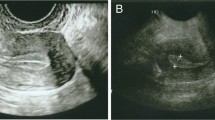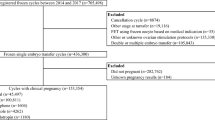Abstract
Purpose
To evaluate whether endometrial compaction using sequential transvaginal ultrasound is associated with improved live birth rates in medicated single euploid frozen embryo transfer (FET) cycles.
Methods
Prospective observational cohort study at a private fertility clinic. Patients who underwent FETs between January and December 2018 were assessed for inclusion. The change in endometrial thickness between the end of the estrogen phase and the day before embryo transfer, measured by sequential transvaginal ultrasound, was used to categorize cycles with compaction (≥ 5%), no change, or expansion (≥ 5%). FET cycle outcomes were then compared between groups. The primary outcome was live birth. Secondary outcomes include clinical pregnancy rate and rate of spontaneous abortion.
Results
Of the 259 single euploid medicated FETs performed during the study period, only 43/259 (16.6%) of the cycles demonstrated ≥ 5% compaction, whereas 152/259 (58.7%) expanded and 64/259 (24.7%) were unchanged. Live birth rates did not differ between cycles with compaction (58.1%), no change (54.7%), or expansion (58.6%), p = 0.96. Clinical pregnancy and spontaneous abortion rates were also similar between groups.
Conclusion
The vast majority of cycles did not demonstrate endometrial compaction. Endometrial compaction is not associated with live birth rate or spontaneous abortion rate in medicated single euploid FETs in this cohort.

Similar content being viewed by others
Data availability
Coded data pertaining to this study are stored on a password- and firewall-protected server and can be made available if needed.
References
Bergh PA, Navot D. The impact of embryonic development and endometrial maturity on the timing of implantation. Fertil Steril. 1992;58:537–42.
Kovacs P, Matyas S, Boda K, Kaali SG. The effect of endometrial thickness on IVF/ICSI outcome. Hum Reprod. 2003;18:2337–41.
Kumbak B, Erden HF, Tosun S, Akbas H, Ulug U, Bahçeci M. Outcome of assisted reproduction treatment in patients with endometrial thickness less than 7 mm. Reprod BioMed Online. 2009;18:79–84.
Yuan X, Saravelos SH, Wang Q, Xu Y, Li TC, Zhou C. Endometrial thickness as a predictor of pregnancy outcomes in 10787 fresh IVF–ICSI cycles. Reprod BioMed Online. 2016;33:197–205.
Zhao J, Zhang Q, Wang Y, Li Y. Endometrial pattern, thickness and growth in predicting pregnancy outcome following 3319 IVF cycle. Reprod BioMed Online. 2014;29:291–8.
Liu KE, Hartman M, Hartman A, Luo ZC, Mahutte N. The impact of a thin endometrial lining on fresh and frozen-thaw IVF outcomes: an analysis of over 40 000 embryo transfers. Hum Reprod. 2018;33:1883–8.
El-Toukhy T, Coomarasamy A, Khairy M, Sunkara K, Seed P, Khalaf Y, et al. The relationship between endometrial thickness and outcome of medicated frozen embryo replacement cycles. Fertil Steril. 2008;89(4):832–9.
Barker MA, Boehnlein LM, Kovacs P, Lindheim SR. Follicular and luteal phase endometrial thickness and echogenic pattern and pregnancy outcome in oocyte donation cycles. J Assist Reprod Genet. 2009;26:243–9.
Griesinger G, Trevisan S, Cometti B. Endometrial thickness on the day of embryo transfer is a poor predictor of IVF treatment outcome. Hum Reprod Open. 2018;(1)1–8.
Haas J, Smith R, Zilberberg E, Nayot D, Meriano J, Barzilay E, et al. Endometrial compaction (decreased thickness) in response to progesterone results in optimal pregnancy outcome in frozen-thawed embryo transfers. Fertil Steril. 2019;112:503–9.
Bu Z, Yang X, Song L, Kang B, Sun Y. The impact of endometrial thickness change after progesterone administration on pregnancy outcome in patients transferred with single frozen-thawed blastocyst. Reprod Biol Endocrinol. 2019;17(1):99.
Zilberberg E, Smith R, Nayot D, Haas J, Meriano J, Barzilay E, et al. Endometrial compaction before frozen euploid embryo transfer improves ongoing pregnancy rates. Fertil Steril. 2020;113:990–5.
Tabibzadeh S. Proliferative activity of lymphoid cells in human endometrium throughout the menstrual cycle. J Clin Endocrinol Metab. 1990;70:437–43.
Author information
Authors and Affiliations
Contributions
C.R., L.K, and A.A. participated in study design. C.R. performed the data collection. C.R., M.Q., L.K., and A.A. participated in data analysis. C.R., M.Q., L.K., A.A., S.G., H.D., and M.S. participated in manuscript drafting and critical discussion.
Ethics declarations
Conflict of interest
The authors declare that they have no conflict of interest.
Ethics approval
This study was approved by the Institutional Review Board of the University of California, Los Angeles (IRB# 18-000559).
Consent to participate
Because of the retrospective nature of this study, the UCLA IRB deemed the study to have minimal risk and waived the requirement for informed consent.
Consent for publication
Consent to publish was not required as the UCLA IRB deemed this study of minimal risk.
Code availability
Code for the data can be made available if required.
Additional information
Publisher’s note
Springer Nature remains neutral with regard to jurisdictional claims in published maps and institutional affiliations.
Supplementary Information
ESM 1
(DOCX 14 kb)
Rights and permissions
About this article
Cite this article
Riestenberg, C., Quinn, M., Akopians, A. et al. Endometrial compaction does not predict live birth rate in single euploid frozen embryo transfer cycles. J Assist Reprod Genet 38, 407–412 (2021). https://doi.org/10.1007/s10815-020-02043-7
Received:
Accepted:
Published:
Issue Date:
DOI: https://doi.org/10.1007/s10815-020-02043-7




